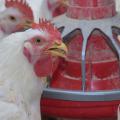Good management of egg producing hens
The modern egg producing strains of chickens usually have fewer poor producing hens if you manage the birds properly as pullets. In commercial egg laying operations the birds are not usually culled after being placed in the laying house unless the birds become diseased or crippled. In the small laying flock the hens should be culled about eight to ten weeks after being placed in the laying house. This allows the birds plenty of time to adjust to their new surroundings and reach peak production. It also provides extra time for the development of the slower maturing pullets. Often you can detect the non-laying or poor producing birds by observing the condition of the comb and head characteristics. Body characteristics will indicate if the bird is capable of being a good layer.
Characteristics Indicating Ability to Lay
|
Character
|
Layer
|
Non-Layer
|
| Comb and Wattles | Large, bright red, glossy | Small, dull, shriveled |
| Head | Neat, refined | Beefy, weak |
| Eye | Bright, prominent | Dull, sunken |
| Eye ring | Bleached | Yellow tinted |
| Beak | Bleached | Yellow |
| Abdomen | Deep, soft, pliable | Shallow, tough, tight |
| Pubic bones | Flexible, wide apart | Stiff, close together |
| Vent | Large, moist, bleached | Small, dry, puckered, yellow |
Culling at night is recommended, since the birds are less likely to be frightened and reduce egg production. A flashlight with the lens covered with blue cellophane will make it easier to detect poor layers without disturbing the flock. Handle the birds as little as possible so that production will not be greatly reduced. Delay culling if a significant portion of the flock is suffering or recovering from a minor disease or molt. Culling a diseased or molting flock often removes some of the better laying birds.
Publications
News
STARKVILLE, Miss. -- Until an avian flu vaccine for chickens or other alternative is federally approved, commercial poultry operations in the U.S.
STARKVILLE, Miss. -- If egg prices have seemed higher than ever lately, it’s because they are, and consumers can place much of the blame squarely at the feet of the ongoing bird flu outbreak.
With highly pathogenic avian influenza, or HPAI, in the environment in Mississippi, owners of backyard flocks have to take extra steps to keep their chickens healthy.
Avian influenza poses an extremely low risk to human health and none to food safety in Mississippi, but its presence poses a risk to backyard flocks and the state’s $3 billion commercial poultry industry.






